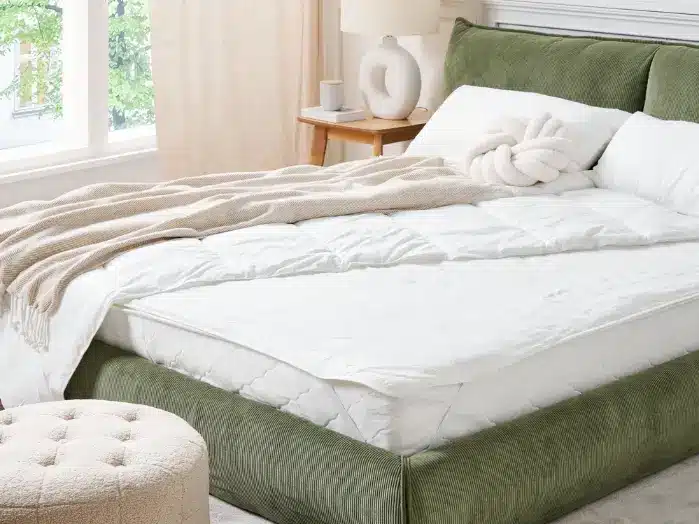Choosing the right mattress plays a key role in achieving quality sleep, and opting for an eco-friendly mattress lets you do so without compromising the health of our planet. As DIY enthusiasts, we have a unique opportunity to make conscious choices that align with our passion for sustainable living. This guide will introduce you to eco-friendly mattresses that provide comfort while minimizing environmental impact. You’ll learn how they are made, what makes them a healthier choice, and how to pick the best one for you.
1. Compare Types of Eco-Friendly Mattresses
Several eco-friendly mattresses are available, each with its unique set of features. The most common types include natural latex, organic cotton, and plant-based memory foam mattresses. A natural latex bed, often considered the most sustainable option, is made from the sap of a rubber tree, a renewable resource. These mattresses are durable, naturally resistant to dust mites, and provide excellent support and comfort.
Organic cotton mattresses are made from cotton grown without harmful pesticides and chemicals, making them a safe and healthy choice. They offer a soft, breathable surface that promotes air circulation, leading to a cooler sleep. On the other hand, plant-based memory foam mattresses are created by replacing some petroleum-based ingredients with plant-derived alternatives. These mattresses offer improved breathability and a quicker response time than traditional memory foam mattresses, providing a comfortable and eco-friendly solution.
2. Understand the Elements of an Eco-Friendly Mattress

Understanding the elements that make a mattress eco-friendly is crucial in making an informed buying decision. The key factors include the materials used, their sourcing, and their manufacturing process. Eco-friendly mattresses are typically made from natural or organic materials such as latex, cotton, or wool, which are renewable and biodegradable. Instead of synthetic materials and harmful chemicals, these mattresses use plant-based foams, natural flame retardants, and organic ticking.
The sourcing of these materials is also essential, with manufacturers ensuring they originate from sustainable, responsibly managed sources. This could mean using latex from rubber trees grown in sustainably managed plantations, cotton from organic farms, or wool from sheep raised on organic pastures. The manufacturing process, too, is designed to minimize environmental impact, often using energy-efficient methods, minimizing waste, and avoiding harmful emissions.
3. Consider Your Sleeping Habits
Your sleeping habits play a significant role in determining the ideal eco-friendly mattress for you. Stomach sleepers often require a firmer mattress to maintain a neutral spine alignment, preventing back pain. On the other hand, side sleepers may prefer a softer mattress that conforms to the body’s curves, providing support to the neck, shoulders, and hips. Back sleepers might opt for a medium-firm mattress that offers a balance of comfort and support.
Eco-friendly mattresses cater to all types of sleepers. For instance, natural latex mattresses are available in various firmness levels. They are known for their supportive and contouring properties, making them suitable for multiple sleeping styles. Organic cotton mattresses often provide a medium level of firmness, offering a balance of comfort and support that is beneficial for back sleepers. Meanwhile, plant-based memory foam mattresses, known for their pressure-relieving qualities, can be an excellent option for side sleepers.
4. Find the Right Fit for Your Home
Finding the right eco-friendly mattress that fits seamlessly into your home involves considering the size of your bed frame and the aesthetics of your space. Mattresses come in standard sizes such as twin, twin XL, full, queen, king, and California king. Measuring your bed frame or box spring is essential to ensure your chosen mattress is the correct size. In addition, consider the thickness of the mattress, as it can impact the overall height of your bed and, consequently, your comfort and ease of getting in and out of bed.
From an aesthetic standpoint, many eco-friendly mattresses offer organic cotton covers in various colors and patterns that can complement your bedroom decor. Some even offer customizable options, allowing you to select the cover design that best aligns with your aesthetic preferences. Remember, however, that a mattress’s primary function is to support quality sleep – while aesthetics are important, they shouldn’t sacrifice comfort and sustainability.
5. Research Available Eco-Friendly Certifications
Understanding the various eco-friendly certifications can significantly assist in discerning truly green products from those that claim to be. Certifications seal a third-party organization’s approval, attesting to the product’s adherence to specific environmental or health standards. Some common certifications you might encounter when shopping for eco-friendly mattresses include CertiPUR-US, Global Organic Textile Standard (GOTS), Global Organic Latex Standard (GOLS), and Greenguard Gold.
CertiPUR-US, for instance, certifies that the foam used in the mattress is free from harmful chemicals and has low VOC (Volatile Organic Compound) emissions for indoor air quality. GOTS and GOLS are international standards that verify that the textiles and latex used are organic and processed without harmful chemicals. The Greenguard Gold certification, on the other hand, ensures that the product meets strict chemical emissions limits, contributing to healthier indoor air.
6. Invest in a Quality Mattress Protector

While eco-friendly mattresses are made with durable materials, investing in a quality mattress protector can help prolong its lifespan. They protect your mattress from spills, stains, and wear and tear, and they also serve as an additional barrier against dust mites and allergens. A good-quality mattress protector will be breathable and hypoallergenic, adding extra comfort to your mattress while ensuring it remains clean, healthy, and durable for years to come.
When selecting a mattress protector, look for eco-friendly options that align with your sustainable lifestyle. These might include protectors made from organic cotton or bamboo, which are naturally hypoallergenic and breathable. Additionally, ensure that the protector fits your mattress size properly and is easy to clean. Remember, the goal is to enhance comfort and prolong the life of your mattress while staying true to your commitment to the environment.
Conclusion
Choosing an eco-friendly mattress allows you to sleep soundly, knowing that your bed is comfortable and sustainable. By understanding the different types of eco-friendly mattresses, their elements, and how they cater to various sleeping habits, you can make an informed decision that suits your needs and preferences. Remember to research available certifications and consider the size and aesthetics of your space when selecting a mattress. With the right eco-friendly mattress and protector, you can sleep peacefully while positively impacting our planet.






